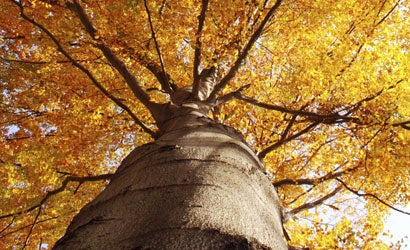Fall Into Photos
Our top tips for making the most of the season's photo ops, from the homecoming game to Thanksgiving dinner.

The calendar is carrying us into a photo-intensive time of year. But autumn’s variety of subjects is enough to challenge the skills of even the best of us. And finding the right settings on a digital camera in every situation can be frustrating.
Don’t be overwhelmed — or worse, turn to scene modes. The goal is to make images that are good, not merely good enough.
With that in mind, here are some tips to help you master the photo ops of the season.
Last of the leaves
In the autumn-color part of the world, how do you improve on what Mother Nature provides? Putting a warming filter on your lens will warm up the scene a bit. Though if I had to choose just one filter for fall, it would be a circular polarizer. Got blue sky behind the leaves? The polarizer punches up the blue. It also zaps color-robbing reflections from the waxy surface of leaves. Or you could combine both effects in one filter, such as Hoya’s Moose Peterson Warming Polarizer ($40-$120, street, depending on size).
As for camera settings, make the most of the colors by dialing up saturation (it’s in the menus). Set it to “Vivid” or your camera’s equivalent. White balance? For frontlit photos, stay with auto. If the trees are backlit, however, set your WB to “Cloudy.” This will take blue out of the shadows and give you much brighter hues.
Thanksgiving dinner
Considering all the work that goes into making the meal, you should give each dish its photographic due. For Martha Stewart-style photos, you’ll need a high-speed macro or portrait lens. An f/1.8 between 50mm and 105mm is perfect. Get low, at the level of the dish, and shoot at the widest aperture. The shallow depth of field provides a dreamy look that has the yams fading off into softness. If it’s a rectangular dish, put a corner in the center of the foreground; this way, the dish spreads out and has more depth. Use a background or tablecloth that contrasts with the food. Mixed light (window light on the food and incandescent in the background) adds warmth, if you keep WB on Daylight.
After the meal, avoid the wide-angle table view. The distortion will make your companions — already fat and happy — look even fatter. Instead, make a more natural and flattering photo by shooting each person individually at about 50mm. Put the camera on a tripod, and use the self-timer or remote release for a shot of yourself at the table. If you need flash, use a hot-shoe unit turned backward and slightly up, so that the light bounces off the wall behind you. Got dark green walls or another hue that will put an ugly cast on skin tones? Bounce the light off the white ceiling.
Now that you have all of these individual shots of everyone at the table, use basic panorama software (it’s probably already in your computer) to stitch them together into one big, happy photo.
|| |—| | Ask John Q. My Labrador retriever is black. Completely black. Every time I photograph him, all I get is a black blob in the frame. Any tips? A. Try shooting print film (for its wide dynamic range), and bounce a hot-shoe flash off the ceiling or wall behind you. Also, add 1 to 1.5 stops of exposure compensation to lighten your wet-nosed subject.| Gridiron, Jr.
The kids are in the game, and you’re on the sidelines with your DSLR. You brought a long lens and a monopod. Now for the settings. If it’s sunny, set the contrast as low as possible to avoid losing details in highlights and shadows. Auto WB is fine. But with a cloudy sky, shift WB to Cloudy.
Exposure? Forget autoexposure. Instead, take a manual reading off your most valuable player, and use that exposure. Recheck it between quarters.
Yes, I know pros live on burst mode. But you shouldn’t. Put the camera on continuous drive, so you can fire fast, but don’t rely on spraying pictures at 3 fps — concentrate on catching peak action. And to keep your camera from bogging down in processing, consider shooting Fine JPEGs, not RAW. Though you’re not firing continuously, set your autofocus to Continuous.
Then, when the action gets close to you, contract the monopod to its shortest length, get low, and shoot up toward your player. The result will be a heroic photo that will be cherished for autumns to come.